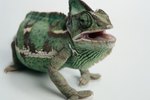
Owning lizards requires you pay close attention to their nutritional needs. Some commercially produced foods sold for geckos contain the same nutritional content that geckos in the wild can eat. For geckos, variety isn't just the spice of life: It's food for life.
Wild Eating Habits
In the wild, geckos eat anything that is small enough for them to overpower or capture and consume. Insects such as crickets and grasshoppers are their mainstay dietary choice in their native unrestricted environment. Geckos will also consume arthropods such as spiders, centipedes and small scorpions. Small rodents -- particularly young still in the nest -- are also on their list of prey. They even have cannibalistic tastes: They will eat hatchling geckos.
Feeding in Captivity
Exact duplication of a wild diet in a captive setting is not a likely option. However, providing a variety of food choices such as crickets, mealworms, silkworms, waxworms and locusts goes a long way toward giving geckos the nutritional variety they require to remain healthy. The bulk of a captive gecko's diet should come from crickets, as the various types of worms geckos enjoy eating do not offer the same level of nutrition as do insects. Fruit flies are like candy to baby geckos -- only they're nutritional. Give adult geckos a pinkie, which is the pet trade industry name for a one-day-old mouse, once a week to simulate their wild habit of eating small rodents.
Crickets
Because crickets are the bulk of a gecko's diet, pay extra attention to obtain quality crickets when feeding captive geckos. Not all crickets contain the same level of nutritional value for your gecko. This is especially true if the cricket has been at the pet store for a longer period of time. The Learning Center at VMSHerp advises "gutloading" crickets, or feeding crickets fresh vegetables and fruits or tropical fish flakes to improve their nutritional value before serving them to the geckos. Allow your gecko five to 20 minutes to eat the crickets. After that, remove uneaten crickets. Leaving uneaten live crickets in your gecko's enclosure after he is full is not advised. Crickets can become aggressive and tear at your gecko's body.
How Often, How Many and How Big
Feed geckos every other day. Two to 10 insects per adult gecko is within normal eating habits. During growth spurts, baby geckos can consume up to 20 crickets at a single feeding. Know the size of your gecko's head before purchasing insects to feed him. It is best to feed a gecko insects that are no bigger than the width of his head to avoid choking and prevent impaction -- a potentially life-threatening condition in which food gets stuck in the gecko's throat or further along his digestive system, causing a blockage.
Water
Every living creature needs access to water, geckos included. A small fairly flat dish that is just large enough for your gecko to slurp out of is recommended. If the dish is too large, your gecko will be tempted to bathe in it and contaminate his drinking water.
References
Photo Credits
-
Hemera Technologies/PhotoObjects.net/Getty Images
Writer Bio
Amy M. Armstrong is a former community news journalist with more than 15 years of experience writing features and covering school districts. She has received more than 40 awards for excellence in journalism and photography. She holds a Bachelor of Arts in communications from Washington State University. Armstrong grew up on a dairy farm in western Washington and wrote agricultural news while in college.



